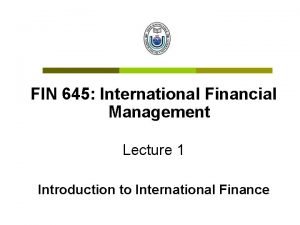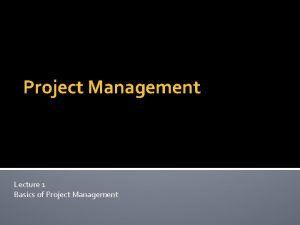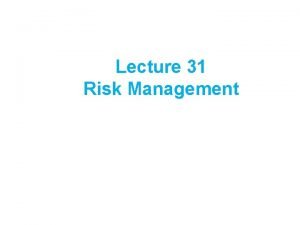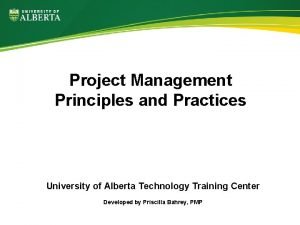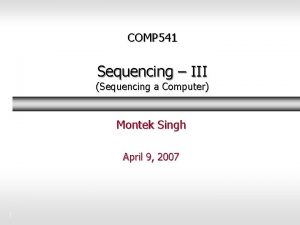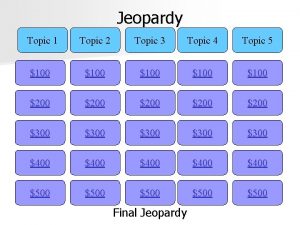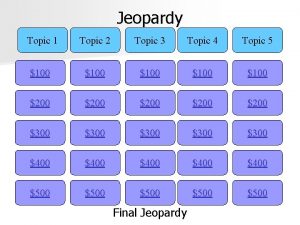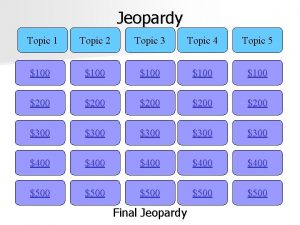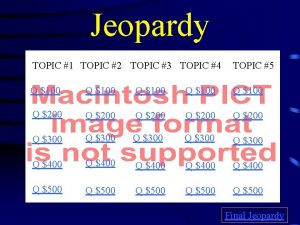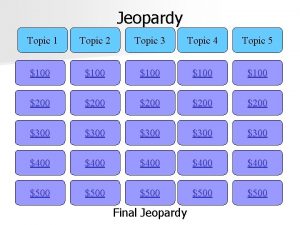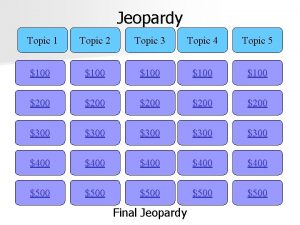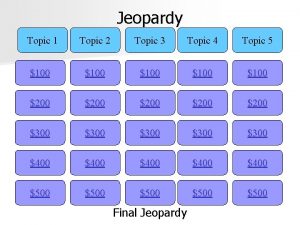Lecture 5 Sequencing Practices III TOPIC MANAGEMENT Dr































- Slides: 31

Lecture 5 Sequencing Practices III TOPIC MANAGEMENT Dr. Ufuk Balaman based on Wong & Waring, 2010

• initiate, • shift, and • exit a topic

• Knowing how to participate in conversations effectively includes knowing how to initiate, shift, and exit a topic smoothly. • After all, we cannot always initiate a topic with Let’s talk about X, shift the topic with Let’s change the topic, and exit the topic with I’m done with this topic.

Topic Management 1. topic initiation, 2. topic pursuit, 3. topic shift, and 4. topic termination

Topic Initiation • Topic initiation refers to practices of starting a new topic (1) at the beginning or closing of a conversation, (2) following a series of silences, or (3) after the closing of a prior topic. • (1) during conversation openings; • (2) after closings have been initiated; • (3) after the shut down of a prior topic; • (4) following a series of silences.

• Methods for initiation a topic • (1) topic initial elicitor; • (2) itemized news inquiry; • (3) news announcement; • (4) pre-topical sequence; • (5) setting talk.

Topic initial elicitor • a three-turn sequence launched by topic initial elicitors • Topic initial elicitor sequence is a three-turn sequence that consists of: • (1) topic initial elicitor (What’s new? ); • (2) newsworthy event (I got a raise. ); • (3) topicalizer (Really? ).




Some topic initial elicitors:

Itemized news inquiry • Itemized news inquiry is a topic initiation method that targets a specific newsworthy item related to the recipient.

Itemized news inquiries take three forms (Button & Casey, 1985, pp. 8– 11): • (1) requests to be brought up-to-date on a recipientrelated event (e. g. , “When are you getting your ↑dining room suite. ”); • (2) solicitous inquiries into recipient troubles(e. g. , “How’s your foot. ”); • (3) inquiries into a recipient-related activity that can possibly generate news (e. g. , “How’s everything at the restaurant? ”).

News announcement • News announcement is a topic initiation method that reports on speaker-related activities.


Pre-topical sequence • Pre-topical sequence is a topic initiation method used to get acquainted with one another with personal questions about the recipient’s identity or activity.

Setting talk • Setting talk is a topic initiation method that points to the immediate environment of the interaction. • Nice day, isn’t it? • Do you have the time? • This bus is taking a long time. • That’s a cool bag.

Topic Pursuit • Topic pursuit refers to practices of insisting upon developing a topic when its initiation receives less-than-enthusiastic responses. • (1) recycling of no-news report; • (2) itemized news inquiry; • (3) return topic initial elicitor; • (4) news announcement; • (5) reclaimer.

Recycling of no-news report

Itemized news inquiry

Return topic initial elicitor

News announcement

Reclaimer • bringing the focus back to themselves

Topic Shift • Topic shift refers to practices of (1) shifting emphasis within a topic or (2) moving towards a new topic either with a disjunctive marker or in a stepwise fashion. • (1) disjunctive topic shift; • (2) stepwise topic shift (cf. “topicshading” in Schegloff & Sacks, 1973).

Disjunctive topic shift • Disjunctive topic shift is a method of moving into a new aspect of the same topic or a new topic by marking such moves as not tightly fitted to the ongoing talk with utterances such as actually or by the way. • Signaling topic shift with a disjunctive marker. • Disjunctive marker is an utterance used to mark the introduction of a new focus or topic as abrupt or unexpected.

• • • • Anyway Alright Oh Speaking of X That reminds me of Ohsay I tell you what One more thing Listen, there’s something I’ve gotta tell you You know what? Before I forget By the way Incidentally



Stepwise topic shift • One can move from one topic or one aspect of a topic to the next in a stepwise (i. e. , gradual) fashion. • In fact, stepwise topic shift is considered “the best way to move from topic to topic” (Sacks, 1992 b, p. 566). • Stepwise topic shift is a method of gradually moving into a new focus or a new topic with the following devices: • (1) pivot + new focus/topic; (2) invoking semantic relationships between items; (3) summary of prior topic → ancillary matters → new topic.

Topic Termination • Topic termination refers to practices of closing down a topic. • Closing a sequence with a sequence closer or an assessment • Utterances such as “well” or “okay” work as possible pre-closings when placed at the end of a topic (p. 303). • SCT • Assessment utterances such as great, good, that’s good, oh splendid, oh great, oh good, lovely, very good

CONVERSATION WORKSHOP
 Hamlet act iii scene iii
Hamlet act iii scene iii 01:640:244 lecture notes - lecture 15: plat, idah, farad
01:640:244 lecture notes - lecture 15: plat, idah, farad Specific topic examples
Specific topic examples Topic down
Topic down Project procurement management lecture notes
Project procurement management lecture notes Strategic management lecture
Strategic management lecture Project management lecture notes
Project management lecture notes Project management lecture notes doc
Project management lecture notes doc Financial management lecture
Financial management lecture Public sector definition
Public sector definition Om 306
Om 306 Performance management lecture
Performance management lecture Human resources department structure
Human resources department structure Chapter 1 introduction to human resource management
Chapter 1 introduction to human resource management Human resource management lecture chapter 1
Human resource management lecture chapter 1 Software cost estimation notes
Software cost estimation notes Project management lecture
Project management lecture Unified health management information system
Unified health management information system Risk management lecture
Risk management lecture Project planning and management lecture notes ppt
Project planning and management lecture notes ppt Network management principles and practice
Network management principles and practice Prm vs crm
Prm vs crm Contemporary management ppt
Contemporary management ppt Security management practices
Security management practices It infrastructure project management best practices
It infrastructure project management best practices Project management practices and principles
Project management practices and principles Post stocking management of pond
Post stocking management of pond Territory management best practices
Territory management best practices Data quality management best practices
Data quality management best practices Grant management best practices
Grant management best practices Contract monitoring best practices
Contract monitoring best practices Fleet maintenance management system best practices
Fleet maintenance management system best practices








